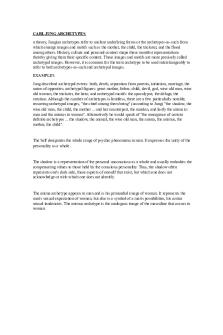Archetypes Jung - Lecture notes 1 PDF

| Title | Archetypes Jung - Lecture notes 1 |
|---|---|
| Author | Pedro Soria Navarro |
| Course | Literatura Inglesa Del Siglo Xviii |
| Institution | Universidad de Alicante |
| Pages | 1 |
| File Size | 51.8 KB |
| File Type | |
| Total Downloads | 98 |
| Total Views | 159 |
Summary
Arquetipos de Jung en relación con las diferentes representaciones en Rasselas de Johnson...
Description
CARL JUNG ARCHETYPES n theory, Jungian archetypes refer to unclear underlying forms or the archetypes-as-such from which emerge images and motifs such as the mother, the child, the trickster, and the flood among others. History, culture and personal context shape these manifest representations thereby giving them their specific content. These images and motifs are more precisely called archetypal images. However, it is common for the term archetype to be used interchangeably to refer to both archetypes-as-such and archetypal images. EXAMPLES Jung described archetypal events: birth, death, separation from parents, initiation, marriage, the union of opposites; archetypal figures: great mother, father, child, devil, god, wise old man, wise old woman, the trickster, the hero; and archetypal motifs: the apocalypse, the deluge, the creation. Although the number of archetypes is limitless, there are a few particularly notable, recurring archetypal images, "the chief among them being" (according to Jung) "the shadow, the wise old man, the child, the mother ... and her counterpart, the maiden, and lastly the anima in man and the animus in woman". Alternatively he would speak of "the emergence of certain definite archetypes ... the shadow, the animal, the wise old man, the anima, the animus, the mother, the child".
The Self designates the whole range of psychic phenomena in man. It expresses the unity of the personality as a whole.
The shadow is a representation of the personal unconscious as a whole and usually embodies the compensating values to those held by the conscious personality. Thus, the shadow often represents one's dark side, those aspects of oneself that exist, but which one does not acknowledge or with which one does not identify.
The anima archetype appears in men and is his primordial image of woman. It represents the man's sexual expectation of women, but also is a symbol of a man's possibilities, his contra sexual tendencies. The animus archetype is the analogous image of the masculine that occurs in women....
Similar Free PDFs

Carl Jung - Lecture notes 1
- 5 Pages

Carl Jung - Lecture notes 3
- 3 Pages

Jung
- 4 Pages

Lecture notes, lecture 1
- 9 Pages

Lecture notes, lecture 1
- 4 Pages

Lecture-1-notes - lecture
- 1 Pages

Lecture notes- Lecture 1
- 20 Pages

Lecture notes, lecture 1
- 4 Pages

Lecture-1 - Lecture notes 1
- 6 Pages

Lecture notes, lecture 1
- 9 Pages

1 - Lecture notes 1
- 11 Pages

1 - Lecture notes 1
- 5 Pages

1 - Lecture notes 1
- 1 Pages

1 - Lecture notes 1
- 24 Pages
Popular Institutions
- Tinajero National High School - Annex
- Politeknik Caltex Riau
- Yokohama City University
- SGT University
- University of Al-Qadisiyah
- Divine Word College of Vigan
- Techniek College Rotterdam
- Universidade de Santiago
- Universiti Teknologi MARA Cawangan Johor Kampus Pasir Gudang
- Poltekkes Kemenkes Yogyakarta
- Baguio City National High School
- Colegio san marcos
- preparatoria uno
- Centro de Bachillerato Tecnológico Industrial y de Servicios No. 107
- Dalian Maritime University
- Quang Trung Secondary School
- Colegio Tecnológico en Informática
- Corporación Regional de Educación Superior
- Grupo CEDVA
- Dar Al Uloom University
- Centro de Estudios Preuniversitarios de la Universidad Nacional de Ingeniería
- 上智大学
- Aakash International School, Nuna Majara
- San Felipe Neri Catholic School
- Kang Chiao International School - New Taipei City
- Misamis Occidental National High School
- Institución Educativa Escuela Normal Juan Ladrilleros
- Kolehiyo ng Pantukan
- Batanes State College
- Instituto Continental
- Sekolah Menengah Kejuruan Kesehatan Kaltara (Tarakan)
- Colegio de La Inmaculada Concepcion - Cebu

